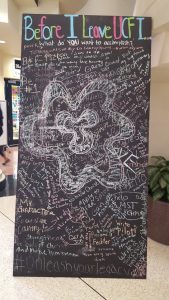Description
One of the major challenges in higher education is for students to find relevance and value in the content they are learning in the classroom (Ambrose, 2010). This extends to the online discussion, where students sometimes do not see the value in actively participating the discussion and do the bare minimum to complete the requirements (Hew, Cheung, & Ng, 2010).
One way to encourage students to actively participate in online discussions is to have them connect what they are learning in the online classroom to their real-world experiences (known as authentic learning) (Herrington & Oliver, 2000).
One strategy to support authentic learning is called the photovoice method. Photovoices’ roots lie in social action and justice, and was originally conducted in face-to-face environments. The purpose of photovoice is for the participants to take pictures in the community that represents something to them, and then peers in the community interpret them. The final product is a collage of the participants’ pictures, which are critically interpreted by the whole community. Implications and actions are then generated from the collage. This method can be applied to the online discussion realm in order for students to connect what they are learning in the classroom to their real-world experiences, which will be diverse and unique. The final product of all of the images serves as an artifact that the students generated.
Link to example artifact(s)
- Instructor: Dr. Beatriz Reyes-Foster, Associate Professor, Anthropology, College of Sciences, UCF
- Course Title: ANT3610: Language and Culture
- Instruction and student example: File:Topr photovoice.pdf
Example of Photovoice
In this 150-student, fully online course, Photovoice was used as a pedagogical strategy in an online graded discussion. Students were already placed into small groups of approximately 8 students. Each group was presented with a prompt directing students to use their mobile devices to take a photograph illustrating a particular course concept. The prompt explained that the assignment was composed of three different parts to be completed on different days. The first part of the assignment was the photograph without context or explanation, the second part asked students to interpret another group member’s photograph using course concepts. Finally, the third part asked students to read the interpretation that had been written about their image, and respond to the interpretation. Please refer to the instructions in the “Topr_photovoice” file above for full details.
Preliminary research on the effectiveness of this pedagogical strategy to foster authentic learning is promising. In a survey conducted with students who encountered this strategy, the majority of students agreed or somewhat agreed that the assignment allowed them to connect course concepts to their own experiences. One student remarked, “Instead of being told what to think about a picture or informed what was going on ahead of time, this assignment allowed for thinking outside the box and use of life experiences to interpret the photo.”
Our results suggest that photovoice may be an appropriate strategy when the focus of the discussion is for the student to connect the content to the world around them. However, it is important to be very clear with instructions. Two things emerged as especially important: (1) Telling students if there are identifiable people in the photo, to get permission to share; (2) If there is anything in the photo that could be perceived as disturbing, to include a ‘content warning’.
A common problem detected during implementation was that students did not always have an interpretation of their own photograph to respond to due to two or more group members simultaneously posting on a single photograph in the group. It is also important to be very clear with the technical instructions, specifically how to add the image to the discussion board in the learning management system. It is also recommended to provide an example, preferably one that students might find non-traditional, in order to stimulate creativity and risk-taking. Debriefing with students after the activity is over is also recommended.
Two articles by the co-authors were published about this strategy: Using the Photovoice Method to Elicit Authentic Learning in Online Discussions and Using Photovoice as a Critical Pedagogical Tool in Online Discussions.
Link to scholarly reference(s)
Ambrose, S.A. (2010). How Learning Works: Seven Research-based Principles for Smart Teaching. San Francisco, CA: Jossey-Bass.
Chio, V., & Fandt, P. (2007). Photovoice in the Diversity Classroom: Engagement, Voice, and the “Eye/I” of the Camera. Journal of Management Education, 31(4), 484-504.
Hergenrather, K., Rhodes, K., Cowan, C., Bardhoshi, G., & Pula, S. (2009). Photovoice as Community-Based Participatory Research: A Qualitative Review. American Journal of Health Behavior, 33(6), 686-698.
Herrington, J., & Oliver, R. (2000). An Instructional Design Framework for Authentic Learning Environments. Educational Technology Research and Development, 48(3), 23-48.
Hew, K.F., Cheung, W.S., & Ng, C.S. (2010). Student contribution in asynchronous online discussion: A review of the research and empirical exploration. Instructional Science, 38, 571-606.
Citation
deNoyelles, A., & Reyes-Foster, B. (2016). Encourage authentic learning in online discussions through photovoice. In B. Chen & K. Thompson (Eds.), Teaching Online Pedagogical Repository. Orlando, FL: University of Central Florida Center for Distributed Learning. https://topr.online.ucf.edu/encourage-authentic-learning-in-online-discussions-through-the-use-of-photovoice/.
